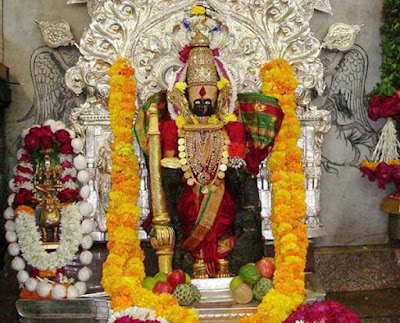Sugandha Shaktipith
is the temple of the Goddess Sunanda, located in the village of
Shikarpur, north of Barisal, Bangladesh. This Hindu temple is one of the
51 Shakti Peethas. The Bhairav is worshipped as Tryambak located in
Ponabalia, 5 miles south of Jhalkati Rail station. Ponabalia is under
the village Sham rail situated on the bank of the river Sunanda.
According to Hindu scripture Nose of Sati fell here. Bhairav is worshipped as Tryambak and Shakti as Sunanda.
According
to the Hindu Scripture the mythology of Daksha yajna and Sati's self
immolation had played a significant role in shaping the ancient Sanskrit
literature and even had impact on the culture of India. It led to the
development of the concept of Shakti Peethas and there by strengthening
Shaktism. Various mythological stories of puranas made the Dakshayajna
as the reason for its origin. It is an important incident in Shaivism
resulting in the emergence of Parvati in the place of Sati Devi and
making Shiva a Grihastashrami (house holder) leading to the origin of
Ganapathy and Subramanian. These are the places that are believed to
have enshrined with the presence of Shakti due to the falling of body
parts of the corpse of Sati Devi, when Lord Shiva carried it and
wandered throughout the universe in sorrow. Each temple has shrines for
Shakti and Kalabhairava and mostly the each temple associates different
names to Shakti and Kalabhairava in that temple.
Sati
was the daughter of King Daksha and Queen. She committed
self-immolation at the sacrificial fire of a yajna performed by her
father Daksha as she felt seriously distraught by her father’s insult to
her husband and also to her by not inviting both of them for the yajna.
Shiva was so grieved after hearing of the death of his wife that
carrying Sati's dead body over his shoulders he danced around the
universe a Tandav Nritya (“devastating penance” or dance of
destruction). In order to bring Shiva to a state of normalcy, it was
then Vishnu who decided to use his Sudarshan Chakra (the rotating
knife's carried on his finger tip). He dismembered Sati’s body into
several pieces and wherever her body fell on the earth, the place was
consecrated as a divine shrine on Shakthi Peeth with deities of Sati
(Parvati) and Shiva. These locations have become famous pilgrimage
places as Shakthi Pithas, and are found all over the subcontinent
including Pakistan, Bangladesh, SriLanka and Nepal, besides India. Sati
is also known as Devi or Shakti, and with blessings of Vishnu she was
reborn as the daughter of Himavat or Himalayas and hence named as
Parvati (daughter of mountains). She was born on the 14th day of the
bright half of the month of Mrigashirsha, which marks the
Shivarathri(Shiva’s night) festival.
Subscribe to:
Post Comments (Atom)









0 comments: